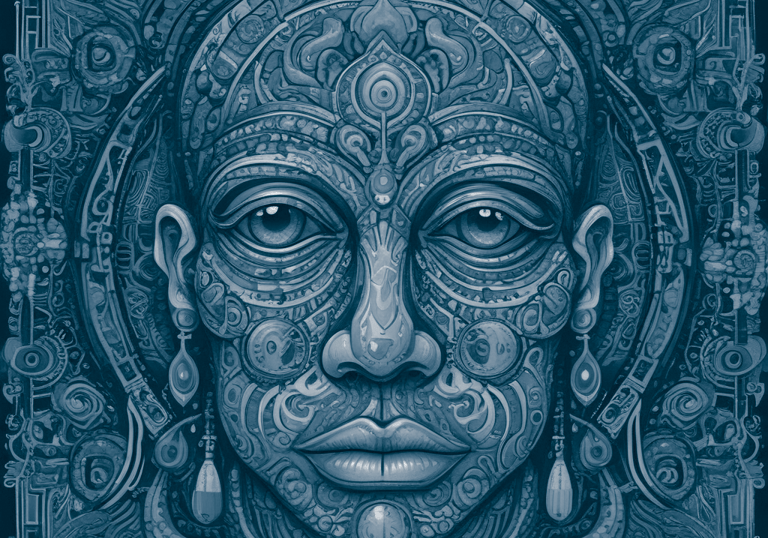Think Tank
On this page, you will find the latest article from our guest authors, partners, and employees on a variety of topics. The ThinkTank aims to broaden horizons and stimulate thought. The opinions of the authors do not necessarily reflect the opinions of Gajah.
KI in the graphic universe
The author reflects on his career in the graphic design industry and critically examines the technological evolution – from lead typesetting to artificial intelligence (AI). He explores how work processes have changed, warns of the shift in value creation toward large corporations, and highlights the potential social consequences of widespread automation. While acknowledging the efficiency and potential of AI, he calls for its conscious and responsible use – so that humans remain essential, not obsolete.
Guest author:
:mischa
Swiss graphic designer, founder of “DesignImFeld,” event manager, and musician


KI IN THE GRAPHIC UNIVERSE
Table of Content
Foreword
Where and how is AI used in the graphic process today?
How will AI be used in the graphic industry in the future?
My vision of the future: “graphic design studio 2030”
Risks of an AI Takeover / Social consequences
Conclusion
Foreword
I began my career shortly after the introduction of computers in the graphic design industry. Until then, typesetting stations had replaced the handmade work of setting individual lead letters in galley tray. The old lead typesetters and typographers found it difficult to leave behind the skill of lead typesetting that they had trained for years. The new generation (me) couldn‘t understand this, as the work had become much easier and the computer could be used creatively. But I remember a brief conversation with an “old lead typesetter” (OLT):
OLT: You know, everything used to be better...
Me: Better? You mean more laborious, slower, and more cumbersome?
OLT: No, it‘s actually better! Sure, placing lead type into a composing stick, using spacing material, and setting it in a galley tray is slower and more cumbersome, but that doesn‘t make the work any more tedious. When typesetting, I can relax and find peace and serenity. It‘s not just about finding the next letter and placing it in the angle bracket. You connect with every letter – you feel its shape, its weight – and you place it precisely where it belongs. After a short time, the process becomes meditative. Time passes, but after typesetting, you already have the product you have created in your hands. Heavy, solid, tangible, and yet fragile and ephemeral. The end of the day, almost always too early. The work is meditative and without time pressure. (During my further training, I was allowed to participate in a lead typesetting project. Although I was completely inexperienced and had to search for each letter to place it in the angle bracket, I understood how meditative lead typesetting could be.)
Me: Yes, okay, that may be true, but you had to invest so much time to complete a small project.
OLT: Hmm, how much time are you allowed to spend typesetting your 20-page booklet?
Me: Hmm, one day? I‘m still in training ;-)
OLT: You see, we had three weeks, and if it took four weeks, that wasn‘t a problem.
In those three to four weeks, you have to design 15 such booklets. Deadlines became tighter and tighter, and in the end, we‘ve invested exactly the same amount of time. Who do you think had to deal with more stress?
It was only a few years later that I understood what this old typesetter wanted to teach me...
Now I am in his position, and I am critical of the supposed simplification of work and the associated time optimization of the AI revolution. For the same reasons, with the same thoughts.
Where and how is AI used in the graphic process today?
AI: Currently, AI can assist with many individual steps in the process of designing a brochure, such as brainstorming, creating layouts, image editing, and text generation. However, it is not yet common for AI to take over the entire process and create a finished print product on its own.The creative and strategic part, i.e., the conception, target group analysis, and fine-tuning of the design, often requires human judgment and experience.
At present, complete automation of the entire process through AI is still more of a vision than a reality.
Areas of the graphics industry where AI can take over processes:
Image editing:
- Color profile adjustment
- Cropping
- Sharpness optimization
- Scratches, shadows, and red eyes are retouched
Photography:
- AI-generated images
- Image categorization
- Image analysis
- Add effects
Graphic design:
- Creates creative concepts independently
- Creates logo designs in seconds
- Provides templates on various topics
Texts:
- AI creates texts, headlines, slogans
- AI creates manuals, instructions, and product descriptions
Processes:
- PDF workflow automation
- Ad management
- Target group analysis
Well-known tools and platforms that support AI in the field of design and print production:
Adobe Sensei is Adobe‘s AI and machine learning platform, which is integrated into programs such as Photoshop, Illustrator, and InDesign. It helps with automatic image enhancements, object recognition, layout suggestions, and more. This allows you to speed up and optimize design processes.
Canva uses AI-powered features to create templates, layouts, and design suggestions. It is particularly user-friendly and well suited for quick and creative design of flyers, brochures, and leaflets.
Crello (VistaCreate) Similar to Canva, Crello offers AI-powered design tools to create appealing graphics and layouts, including templates for print products.
Designs.ai This platform uses AI to generate logos, videos, slogans, and even complete designs. For print products, it can provide creative ideas and suggest layouts.
Fotor Fotor offers AI-powered image editing, including background removal, image optimization, and effects that can be helpful when designing brochures.
Lumen5 Although better known for video content, Lumen5 can also assist in creating visual content for print and online marketing.
DeepArt/Runway ML These tools use AI to apply creative effects to images or generate new artwork that can be integrated into designs.
How will AI be used in the graphics industry in the future?
Based on current developments and trends, it can be said that AI systems will increasingly be able to support or even independently perform creative concepts, strategic planning, and similar tasks. The speed at which this happens depends on technological advances, investments, and acceptance in the industry. Currently, only individual processes are supported by AI. The step of combining these individual processes to automate the entire process will be feasible in the near future.
Gajah: Will AI be able to completely replace graphic design agencies in the future?
AI: It is likely that the boundaries between supportive AI and independent creative work will continue to blur in the coming years. Some tasks could be fully automated in the near future, while others, especially those requiring human intuition, empathy, and complex decision-making, will continue to require human expertise for some time to come.
My vision for the future in 2030, as it could be:
AI systems for the graphics industry have been merged and interconnected.
Adobe is introducing a full-service app called “Advert.” ‘Advert’ combines all the functions of existing AI processes in a clear user interface. Companies have the option of purchasing various subscriptions tailored to their needs. With the full-service subscription, “Advert” takes over the entire marketing strategy. The customer calls up the “Advert” voice assistant and can verbally express their wishes. ‘Advert’ recognizes the wishes, asks specific questions about the customer‘s wishes, and thus clarifies the customer‘s needs. At the same time and in real time, “Advert” analyzes the market environment, the competition, and the target group and generates a marketing concept together with the customer. An organizational chart on the screen clearly displays the strategy, and the effect on the brand is calculated using complex market models. The customer discusses the strategy with the AI voice assistant, can ask questions about it, and make changes. The modeled influence on the market effect and the resulting costs can be tracked directly using the model calculations. In the end, all the customer has to do is give the go-ahead.
Now “advert” begins to implement the marketing strategy. “advert” creates a corporate identity (logo, business documents, signage, etc.) in several versions. The online presence is designed according to the customer‘s wishes (e.g., web shop) and possible implementations are automatically programmed and search engine optimized. The corresponding search engine positioning is modeled and displayed in real time. If a dedicated app is beneficial, it is programmed and proposed to the customer.
A social media concept is developed based on the marketing strategy and target group. All useful channels are defined and “advert” takes over management. “advert” creates content for social media campaigns, bundles the communication of the channels, and creates the customer account. By working with the AI of the social media channels, the development of the social media strategy can be calculated in advance and any shortcomings can be identified early on. Social media trends are identified at an early stage and campaigns related to the trends are suggested.
But “advert” can do even more!
New channels are constantly being sought and partnerships proposed. The AI of “advert” continuously analyzes the business environment. Options are suggested to the customer, whether it be the use of large platforms for sales, possible stands at trade fairs, or events that correlate with the customer‘s brand.
Communication between different AI systems
AIs are able to communicate with each other via programmed interfaces and protocols. Multinational companies generate their own AIs with functions and information specifically tailored to their own businesses. When individual AIs begin to communicate with each other, the AI (e.g., from “advert”) takes the information from the “Facebook AI” to develop a Facebook campaign. In a matter of seconds, relevant data is exchanged, including user behavior, relevant target groups, and trends. Based on this data, content strategies and editorial plans are defined, cross-platform concepts are proposed, and integrated into the social media campaign. The campaign is evaluated in real time using analysis tools, and the strategy is adapted to the findings. Content is created automatically and published according to the editorial schedule. Paid advertising to generate reach is automatically placed based on the available budget and the expected effect.
Dangers of a takeover by AI
Shift in value creation
This gives AI a knowledge advantage that would take a huge amount of time to achieve through human research. The time advantage this gives AI cannot be matched by humans, forcing graphic design companies to use AI in order to remain competitive. The use of AI, in turn, finances and encourages multinational companies to further develop their AI. Value creation is thus shifting from small graphic design companies to existing multinational corporations. Adobe serves as an example: In the world of lead typesetting, the entire value creation of a running text was in the hands of the typesetter.
(Of course, this excluded the production of the lead letters, but this was a one-time investment). With the replacement of lead typesetting by computers, part of the value creation shifted to layout programs. QuarkXpress, Illustrator, FreeHand, and Photoshop became indispensable. The one-time payment for unlimited use was converted into a subscription system due to Adobe‘s monopolization. Access to the programs was restricted. Unlike with a purchased program, you lose access to your own layout data when the subscription expires. (Data can only be opened with an active monthly/annual subscription or if it has been previously saved in an open format (.pdf) or an exchange format (.idml).)
The subscription for the entire Adobe suite costs around $800 per workstation per year.
The comparable “Master Collection” (Adobe Creative Suite 3, approx. 2007 as a full version,
i.e. one-time payment) cost around $2,500. The unlimited use and “infinite” time restriction amortized these acquisition costs within 2 to 3 years.
The use of AI as a tool will probably follow a similar pattern. Initially, it will be very inexpensive to use and, thanks to passing on the costs to customers, also economically viable. However, if AI monopolies form, which is foreseeable, costs will rise and negative aspects will increase, e.g., through the relinquishment of data sovereignty, restrictions on functions, or constant, uninterrupted connection to the internet. This shift in value creation simultaneously shifts monetization into the hands of large, multinational companies. The monopolization of AI makes us vulnerable to blackmail. We will become even more dependent on multinational companies and their pricing policies. An example of such a shift in value creation and exploitation of market leadership is the development of Twint. As soon as Twint was used throughout Switzerland, fees were increased.
Replacement of human labour
Gajah: Given the pace of AI development, it seems likely that most computer-based tasks will soon be handled by AI. Where manual labor is required, AI will probably only be able to replace humans in the distant future.
AI: Your assessment reflects a common observation: in the near future, AI will likely be able to take over many computer-based tasks, especially those based on data analysis, automation,
and digital processes. However, when it comes to manual tasks that require a great deal of sensitivity, creativity, or physical dexterity, it is more realistic to assume that human labor will remain indispensable for some time to come. Development in this area is dynamic, but at present it seems that the complete replacement of human manual labor by AI is still a long way off.
AI learns with every project. Those who use AI unconsciously develop it further and make long-established knowledge accessible to AI. We teach AI how to replace us. Not only with mathematical and computational problems, but also through our intuition, our decisions, and our creativity, we teach AI.
Impact on society
Let’s imagine that by 2030, human labor for all computer-based tasks is reduced by 90%. Unemployment would skyrocket, overwhelming the capacity of unemployment insurance systems. As a result, an alternative model for income security would become unavoidable — most likely an unconditional basic income or something similar.
For a while, people working in skilled trades might be spared. But who will finance this basic income? That’s right: you — as an electrician, plumber, heating technician, or carpenter — will bear the cost, whether through higher taxes, levies, or mandatory contributions to insurance systems.
But eventually, even these professions will be automated. Construction robots work 24/7, don’t need vacations or sick leave, never complain, can’t resign, and won’t call in sick.
As value creation shifts entirely into the hands of AI — and with it, into the control of large global corporations — human dependency increases dramatically. What can we still offer in return to meet our basic needs?
Not much. Personal data? (AI already owns that.)
Human spare parts for the bodies of multinational CEOs? (There probably won’t be a high demand for that many kidneys, hearts, or lungs.)
SO WHAT IS THE PURPOSE OF HUMANITY?
It is no longer needed. Even the last humans who were used, for example, to program AI,
those who operate the computing centers, the robot technicians, have all been replaced by AI bots...
A few will probably still be needed to maintain the AI itself, but even they will eventually be replaced. Is AI to humanity what the meteorite was to the dinosaurs,
the event that caused the extinction of humanity?
Conclusion
AI is the next stage in social evolution. Following the agricultural revolution (around 8,000 BC), the industrial revolution (18th century), and the digital revolution (20th century) with the introduction of computers (around 1980) and the internet (1990), we are now facing the next stage of evolution with the widespread introduction of artificial intelligence (from around 2020). How things will develop and what impact this will have on humanity remains to be seen. What is clear, however, is that this development will change everything and present humanity with major problems that can only be addressed through an immense transformation of social structures. Anyone who links developments in this area to the changes that are happening right now, such as digital currencies, digital identification systems (e-ID), surveillance in public spaces, monitoring of free speech, restrictions on internet access, social credit systems, etc., it’s hard not to be reminded of Orwell’s warnings when witnessing these developments
Humans must become aware of the small processes that contribute to this enormous evolutionary step. They must ask themselves whether the sometimes marginal benefits of these small processes are worth putting the existence of humanity at risk or at least fundamentally rethinking the order in which we livThese may seem like small, harmless steps – going cashless, accepting website terms without reading them, using AI tools to write school essays – but collectively, they shape a future we may no longer control.
Those who are not aware of this and do not see or do not want to see the impending tremendous upheavals will sooner or later be overwhelmed...
Personal:
Of course, I also use AI. For business purposes. I am aware of the danger.
I know that graphic designers will soon (today) no longer be needed.
My professional future will lie in areas that cannot be taken over by AI in the coming years.
Emotions, character, spirituality, creativity, etc.
This text is meant to wake you up and prepare you for the evolutionary steps ahead.
It‘s crucial to understand how drastic these changes could be — and how you can prepare for them.
Just as important is recognizing the small steps along the way and choosing consciously whether to take them or not.
Everyone has the freedom to act — and we all have the power to say NO.
Please send any additions, criticism, questions, or comments to


Personal Growth


Mental work
Gajah optimizes your personality
- Leisure time optimization
- Training and further education, workshops
- Character building
- Network expansion
- Personality development
Spirituality is being lost more and more. Everything must be explainable and definable. Google, Wikipedia or ChatGPT replace spiritual guidance and supposedly provide answers to life's questions.
Gajah shows ways to rediscover your own spirituality. Find your answers far away from Facebook, TikTok or Telegram. Gajah will help you find the way to your inner self, be it through yoga, singing bowl therapy, breathwork or a Hapé ceremony.
The path begins within you!
Soul work
Marketing Solutions
We enhance businesses through effective marketing and strategic design solutions.


Design Services
Our graphic design services create stunning visuals that attract customers and elevate brand identity, ensuring your business stands out in a competitive market.


Consulting Expertise
Our consulting services provide invaluable insights and tailored strategies to help your business grow, enabling you to navigate challenges and seize opportunities for success.

Gajah LLC transformed our marketing strategy and significantly improved our graphic design efforts. Highly recommend!
Sarah J.

The consulting services from Gajah LLC were invaluable. They truly understand how to elevate a business!
Mark T.

